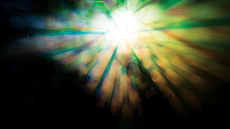The oldest light in the universe
 |
The Cosmic Microwave Background, leftover light from the big bang, carries a wealth of information about the universe — for those who can read it. Photo: Reidar Hahn |
Fifty years ago, two radio astronomers from Bell Labs discovered a faint, ever-present hum in their telescope that they couldn't identify. After ruling out radio broadcasts, radar signals, a too-warm receiver and even droppings from pigeons nesting inside the scope, they realized they'd found a soft cosmic static that originated from beyond our galaxy. Indeed, it seemed to fill all of space.
Fast-forward five decades, and the static has a well-known name: the cosmic microwave background, or CMB. Far from a featureless hum, these faint, cold photons, barely energetic enough to boost a thermometer above absolute zero, have been identified as the afterglow of the big bang.
This light — the oldest ever observed — offers a baby picture of the very early universe. How early? The most recent result, announced on Saint Patrick's Day 2014 by the researchers of the BICEP2 experiment, used extremely faint signals imprinted on CMB photons to reach back to the first trillionth of a trillionth of a trillionth of a second after the big bang — almost more of a cosmic sonogram than a baby picture. This image offered the first direct evidence for the era of cosmic inflation, when space itself ballooned outward in a turbocharged period of expansion.
CMB photons have more to tell us. Combined with theoretical models of cosmic growth and evolution, ongoing studies will expand this view of the very early universe while also looking forward in time. The goal is to create an entire album chronicling the growth of the universe from the very moments of its birth to today.
Further studies promise clear insight into which of the many different models of inflation shaped our universe, and can also help us understand dark matter, dark energy and the mass of the neutrino — if researchers can read the CMB in enough detail.
That's not easy, though, because the afterglow has faded. During its epic 13-billion-year-plus journey, light that originally blazed through the universe has stretched with space itself, its waves growing billions of times longer and cooler and quieter.
Relic radiation
The Standard Model of Cosmology says that about 13.8 billion years ago, the universe was born from an unimaginably hot, dense state. Before a single second had ticked away, cosmic inflation increased the volume of the universe by an amount that varies according to the particular model, but always features a 10 followed by about 30 to 80 zeroes.
When inflation hit the brakes, leftover energy from that expansion created many of the particles we see around us today: gluons, quarks, photons, electrons and their bigger brethren, muons and taus, and neutrinos. Primordial photons scattered off free-floating electrons, bouncing around inside the gas cloud that was the universe. Hundreds of thousands of years later, the cosmic cloud of particles cooled enough that single protons and helium nuclei could capture the electrons they needed to form neutral hydrogen and helium. This rounded up the free electrons, clearing the fog and releasing the photons. The universe began to shine.
These photons are the cosmic microwave background. Although now weak, they are everywhere; CMB photons bathe the Earth — and every other star, planet, black hole and hunk of rock in the universe — in their cold light.
Read more
—Lori Ann White
|